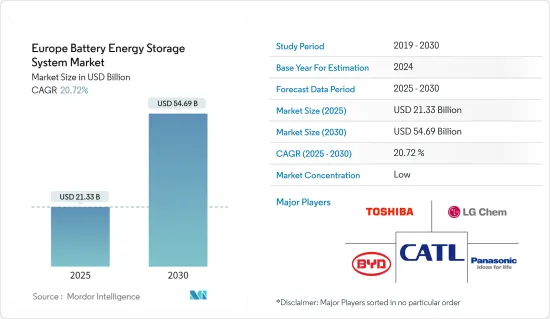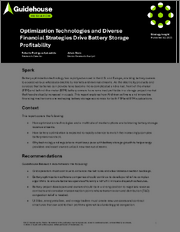
|
시장보고서
상품코드
1683440
유럽의 배터리 에너지 저장 시스템 : 시장 점유율 분석, 산업 동향, 통계, 성장 예측(2025-2030년)Europe Battery Energy Storage System - Market Share Analysis, Industry Trends & Statistics, Growth Forecasts (2025 - 2030) |
||||||
유럽의 배터리 에너지 저장 시스템 시장 규모는 2025년에 213억 3,000만 달러 규모에 이르고, 예측 기간 중(2025-2030년) CAGR은 20.72%를 나타낼 전망이며, 2030년에는 546억 9,000만 달러에 달할 것으로 예측됩니다.

주요 하이라이트
- 중기적으로는 신재생에너지 도입 증가나 리튬이온 배터리 가격 하락 등의 요인이 유럽의 배터리 에너지 저장 시스템 시장을 견인할 것으로 보입니다.
- 한편, 전지 제조에 사용되는 원재료 수요 및 공급 불일치가 예측 기간 동안 시장을 억제할 것으로 예상됩니다.
- 리튬 유황 전지나 고체 전지 등의 신세대 전지는 효율 향상이나 생산 규모 확대 등의 기술 개량에 의해 2030년 또는 2035년까지 시장을 석권할 것으로 예상됩니다. 이러한 배터리의 진보는 향후 유럽의 배터리 에너지 저장 시장에 몇 가지 기회를 가져올 것으로 예상됩니다.
- 독일은 에너지 수요가 증가함에 따라 예측 기간 동안 가장 빠르게 성장하게 될 시장입니다. 이 성장은 일본의 정부 지원 정책과 함께 투자가 증가하고 있기 때문입니다.
유럽 배터리 에너지 저장 시스템 시장 동향
리튬이온 부문이 시장을 독점할 전망
- 리튬 이온(Li-ion) 전지는 충방전 효율이 거의 100%로, 동일한 암페어시(Ah) 용량을 드나들 수 있습니다. 이 배터리는 납 축전지와 같은 다른 기술에 비해 다양한 기술적 이점을 가지고 있습니다. 충전식 리튬 이온 배터리는 평균 5,000회 이상의 사이클을 제공합니다.
- 리튬 이온 배터리는 여러 번 충전 할 수 있으며 보다 안정적입니다. 또한 다른 충전식 배터리 보다 에너지 밀도, 전압 용량, 자기 방전율이 높은 경향이 있습니다. 이는 단일 셀이 다른 배터리 유형보다 더 긴 충전 유지 시간을 가지므로 전력 효율성을 향상시킵니다.
- 또한, 세계의 리튬 이온 배터리 제조업체는 리튬 이온 배터리의 비용 절감에 주력하고 있습니다. 리튬 이온 배터리의 가격은 지난 10년간 급락했습니다.
- 2023년 리튬 이온 배터리 팩의 가격은 1킬로와트 당 139달러로 떨어졌으며, 전년 1킬로와트 당 161달러 이상으로 떨어졌습니다. 리튬 이온 배터리는 높은 효율로 세계적으로 인정받고 있으며 최고의 에너지 저장 장치로 눈에 띄고 있습니다.
- 최근, 대규모 생산이 급증하고, 전지 제조에 상당 액의 설비 투자가 행해져, 리튬 이온 전지 팩의 효율 향상과 코스트 삭감으로 이어지고 있습니다. 이러한 추세는 에너지 저장에 대한 강력한 글로벌 수요를 강조하며, 이는 주로 전 세계적인 재생 에너지 경제로의 전환과 전기 자동차의 지속적인 역할 확대에 의해 주도됩니다.
- 리튬 이온 배터리는 태양광 발전, 풍력 발전 및 기타 배터리 에너지 저장 시스템에 사용되기 때문에 배터리 저장 시스템에서 중요한 의미를 가지고 있습니다. REPowerEU 계획에 따르면 이 지역은 2030년까지 재생 가능 에너지 발전 용량을 1,236GW로 늘릴 계획입니다. 이로 인해 배터리 에너지 저장 시스템에도 비즈니스 기회가 생길 것으로 기대됩니다.
- 2050년까지 탄소 중립을 목표로 하는 유럽에서는 재생 가능 에너지의 도입량이 대폭 증가하고 있습니다. 예를 들어, 이 지역에서는 2023년에 약55.9GW의 새로운 태양광 발전 용량과 17GW의 풍력 발전 용량이 새롭게 설치했습니다. 태양광, 풍력, 지열과 같은 재생 가능 에너지원은 에너지 저장 시스템에 리튬 이온 배터리를 사용합니다.
- 유럽 국가들은 신재생에너지 도입을 가속화하기 위해 보조금 규정을 끌어올리는 움직임을 강화하고 있습니다. 예를 들어, 그리스 정부는 2024년 2월 'Photovoltaics on the Roof(지붕 위의 태양광 발전)'라고 명명한 약 2억 6,180만 달러 상당의 프로그램을 전개해, 이 나라에 있어서의 축전지와 일체화한 태양광 발전의 지붕에의 도입을 조성했습니다. 따라서 이 재정 조치는 재생가능 에너지 프로젝트에서 배터리 에너지 저장 시스템을 개선할 가능성이 높으며, 예측 기간 동안 유럽에서 리튬 이온 배터리를 판매하는 데 이익을 줄 수 있습니다.
- 마찬가지로 독립형 배터리 에너지 저장 시스템 프로젝트는 이 지역의 신뢰할 수 있는 백업 전원과 프라임 전원 공급 장치에서 견인력을 얻고 있습니다. 예를 들어, 2024년 9월, 환경 에너지부는 배터리 에너지 저장 시스템의 가동 전력 범위를 결정하는 법령을 제정했습니다. 처음 두 경매에서 부여된 지원금을 합치면 총량은 900MW에 달해 원래 목표였던 1,000만MW에는 약간 미치지 못합니다. 그리스에서 배터리 에너지 저장 시스템(BESS)의 자본 지출(설비 투자) 보조금은 1MW당 21만 5,900달러가 상한입니다. 경매에서 최대 입찰가는 연간 1MW당 15만 6,528달러로 제한되어 있습니다.
- 리튬 이온 전지의 채택이 증가하고 있지만, 주된 이유는 가장 에너지 효율이 높은 충전식 배터리라는 특성입니다. 또한 리튬 이온 배터리는 기술 경제적인 장점이 있기 때문에 기존 배터리를 대체하고 있으며 사용량이 증가하고 있습니다.
- 따라서 위의 점들로 인해 리튬 이온 부문이 예측 기간 동안 유럽의 배터리 에너지 저장 시스템 시장을 독점할 가능성이 높습니다.
독일이 시장을 독점할 전망
- 독일은 유럽과 세계에서 에너지 저장의 최대 시장 중 하나입니다. 이 나라의 에너지 저장 시장은 2050년까지 온실가스 배출량을 최소 80% 삭감(1990년 대비)하는 야심적인 에너지 전환 프로젝트와 목표에 따라 최근 크게 활발해지고 있습니다. 이 나라는 또한 2023년까지 원자력발전소를 단계적으로 폐지할 계획을 세우고 있으며, 감소하는 발전능력을 보충하기 위해 재생가능에너지의 개발이 증가할 것으로 예상됩니다.
- 독일의 에너지 저장 시장은 최근 몇 년간 큰 성장을 보이고 있는데 이는 이 나라의 야심찬 에너지 전환 프로젝트 "Energiewende" 덕분에 크게 성장했습니다. 배터리 및 기타 저장 기술의 붐은 독일의 에너지 전환에 큰 영향을 미칠 것으로 예상됩니다.
- 이 나라의 배터리 저장 주요 원동력은 리튬 이온 배터리가 가전 및 기타 용도에 널리 사용되기 때문에 가격이 급락하고 있다는 것입니다. 지난 5년간 독일의 배터리 비용은 절반 이상 감소하였고, 이러한 추세는 앞으로도 계속될 것으로 예상됩니다.
- 유럽 에너지 저장 협회(EASE)에 따르면 유럽에서는 2030년까지 약 187GW의 에너지저장이 필요할 것이며, 그 중 배터리 저장은 122GW를 차지하게 될 것으로 예측합니다. 이는 러시아와 우크라이나 전쟁에서 가장자리를 뚫은 에너지 위기의 후유증을 극복하기 위해 독일과 같은 국가가 에너지 공급을 보장하기 위해 배터리 저장 솔루션을 빠르게 개발하고 있음을 의미합니다.
- 또한 독일에서는 온실가스 배출을 억제하기 위한 기후 변화 대책이 시작되고 있으며, 정부는 2030년까지 에너지 믹스의 자연 에너지 비율을 50%, 2050년까지 최소 80%로 끌어올릴 것을 의무화하고 있습니다. 이 때문에 독일에서는 간헐성에 대항하고 피크시 이외의 잉여 에너지를 저장하기 위해 추가 배터리 에너지 저장 시스템이 필요할 것으로 보입니다.
- 독일 German Trade and Invest(GTAI)에 따르면 2031년까지 독일에는 배터리 개조 잠재력이 있는 태양광 발전 설비가 25만기 설치될 전망입니다. 오래된 태양광 발전에 대한 20년 보증의 고정가격 임베디드제도는 단계적으로 폐지되기 때문에 개조 설치가 예측기간 동안 독일의 주택용 에너지 저장시장을 견인할 가능성이 높습니다.
- 목표에 관해서는 독일의 국가 축전지 목표는 2037년에 21-26GW를 달성하는 것이며, 2022년에는 0.9GW였습니다. 또한, 이 나라가 석탄을 폐지하고 재생가능 에너지원을 중시하는 움직임을 추진하고 있기 때문에 배터리 에너지 저장 시장은 향후 수 년간 가장 중요하게 될 것입니다.
- 2023년 독일의 태양광 발전에 의한 발전량은 61.2테라와트시의 전력을 생산했습니다. 2012년부터 2021년까지 생산량은 약간의 변동이 있었지만 발전량은 30테라와트시 가까이 증가했습니다. EU의 태양광 발전에 압도적인 힘을 가진 독일은 2023년 전력 생산량으로 모든 회원국을 앞질렀습니다.
- 예를 들어, 2024년 7월 프랑스의 에너지 대기업 TotalEnergies SE는 독일에 100MW/200MWh의 배터리 에너지 저장 시스템(BESS)을 설치하는 프로젝트를 승인했습니다. 프랑스 그룹이 발표한 바와 같이 이 프로젝트는 약 8,130만 달러의 투자를 초과할 것으로 보입니다. 노르트라인-베스트팔렌주 다렘에 설치된 이 배터리는 토탈에너지스의 배터리 계열사 자프트사의 리튬철 인산염 기술을 이용합니다. 2026년 후반에 상업운영을 시작할 예정입니다.
- 따라서 이러한 정부의 이니셔티브로 독일에서는 에너지 저장 시스템 수요가 높아질 가능성이 높습니다.
유럽 배터리 에너지 저장 시스템 산업 개요
유럽 배터리 에너지 저장 시스템 시장은 여러 업체로 분산되어 있습니다. 이 시장의 주요 기업(특정 순서 없이)에는 BYD Company Ltd., Contemporary Amperex Technology, LG Energy Solution Ltd., Panasonic Holdings Corporation, Toshiba Corp. 등이 있습니다.
기타 혜택:
- 엑셀 형식 시장 예측(ME) 시트
- 3개월간의 애널리스트 서포트
목차
제1장 서론
- 조사 범위
- 시장의 정의
- 조사의 전제
제2장 주요 요약
제3장 조사 방법
제4장 시장 개요
- 소개
- 2029년까지 시장 규모 및 수요 예측(단위: 달러)
- 최근 동향과 개발
- 정부의 규제와 정책
- 시장 역학
- 성장 촉진요인
- 신재생에너지 도입 증가
- 리튬 이온 전지의 비용 저하
- 억제요인
- 다른 에너지 저장 시스템으로 이동
- 성장 촉진요인
- 공급망 분석
- Porter's Five Forces 분석
- 공급기업의 협상력
- 소비자의 협상력
- 신규 참가업체의 위협
- 대체품의 위협
- 경쟁 기업간 경쟁 관계의 강도
- 투자분석
제5장 시장 세분화
- 배터리 유형
- 리튬 이온 배터리
- 납축전지
- 플로우 배터리
- 기타 배터리 유형
- 용도
- 주택
- 상업 및 공업
- 유틸리티
- 지역
- 독일
- 영국
- 프랑스
- 이탈리아
- 스페인
- 북유럽 국가
- 러시아
- 터키
- 기타 유럽
제6장 경쟁 구도
- 합병, 인수, 제휴, 합작 사업
- 주요 기업의 전략
- 기업 프로파일
- BYD Company Ltd.
- Tesla Inc
- Contemporary Amperex Technology Co Ltd.
- Panasonic Holdings Corporation
- Murata Manufacturing Co., Ltd.
- Leclanche SA
- LG Energy Solution Ltd.
- Samsung SDI Co Ltd.
- Toshiba Corporation
- Wartsila Oyj Abp
제7장 시장 기회와 앞으로의 동향
- 배터리 기술의 기술적 진보
The Europe Battery Energy Storage System Market size is estimated at USD 21.33 billion in 2025, and is expected to reach USD 54.69 billion by 2030, at a CAGR of 20.72% during the forecast period (2025-2030).

Key Highlights
- Over the medium term, factors such as increase in adoption of renewable energy and declining lithium-ion battery prices are likely going to drive the European battery energy storage system market.
- On the other hand, the mismatch in the demand and supply of the raw materials used for battery manufacturing is expected to restrain the market during the forecast period.
- New generation batteries, such as lithium-sulfur and solid-state, due to technological improvements such as an increase in efficiency and production scale-up, are expected to take over the market by 2030 or 2035. These advancements in batteries are expected to create several opportunities for the European battery energy storage market in the future.
- Germany is the fastest-growing market during the forecast period due to the rising energy demand. This growth is attributed to increasing investments, coupled with supportive government policies in the country.
Europe Battery Energy Storage System Market Trends
Lithium-ion Segment Expected to Dominate the Market
- Lithium-ion (Li-ion) batteries are nearly 100% efficient in charge and discharge, allowing the same ampere-hours in and out. These batteries offer various technical advantages over other technologies, such as lead-acid batteries. Rechargeable Li-ion batteries, on average, offer cycles more than 5,000 times, compared to lead-acid batteries that last around 400-500 times.
- Li-ion batteries can be recharged numerous times and are more stable. Furthermore, they tend to have a higher energy density, voltage capacity, and lower self-discharge rate than other rechargeable batteries. This improves power efficiency as a single cell has longer charge retention than different battery types.
- Further, the global lithium-ion battery manufacturers are focusing on reducing the cost of Li-ion batteries. The price of lithium-ion batteries declined steeply over the past ten years.
- In 2023, the price of lithium-ion battery packs fell to USD 139 per kilowatt-hour, a decrease from over USD 161 per kilowatt-hour the previous year. Recognized globally for their efficiency, lithium-ion batteries stand out as premier energy storage devices.
- Recent years have witnessed a surge in large-scale production and significant capital investments in battery manufacturing, leading to enhanced efficiency and reduced costs for lithium-ion battery packs. This trend underscores a robust global demand for energy storage, largely driven by the world's pivot towards a renewable energy economy, with electric vehicles playing an ever-expanding role.
- Lithium-ion batteries have significance in battery storage systems as they are used in solar, wind, and other battery energy storage systems. As per the REPowerEU plan, the region has planned to bring total renewable energy generation capacities to 1,236 GW by 2030. This is expected to create opportunities for battery energy storage systems as well.
- Renewable energy installations are rising significantly in Europe, which has targeted becoming carbon neutral by 2050. For instance, the region installed around 55.9 GW of new solar capacity and 17 GW of wind capacity in 2023. Renewable energy sources such as solar, wind, geothermal, and others rely upon lithium-ion batteries for energy storage systems.
- European countries are increasingly raising the provisions for subsidies to accelerate renewable energy adoption. For instance, in February 2024, the government of Greece rolled out a program named "Photovoltaics on the Roof" worth about USD 261.8 million to subsidize the deployment of solar rooftops integrated with battery storage in the country. Hence, the fiscal measure is likely to uplift battery energy storage systems in renewable energy projects, which could benefit the sale of lithium-ion batteries in Europe in the forecast period.
- Likewise, the standalone battery energy storage system projects are also getting traction at the outset of the region's reliable backup power and prime power supply. For instance, in September 2024, The Ministry of Environment and Energy set a decree to determine the operating power quota of battery energy storage systems. Combined with the support granted in the initial two auctions, the total volume would hit 900 MW, falling slightly short of the initially targeted 1,000 MW. In Greece, capital expenditures (capex) grants on battery energy storage systems (BESS) are capped at USD 215,900 per MW. In the auction, the maximum bid is limited to USD 156,528 per MW annually.
- The adoption of Li-ion batteries has been increasing, primarily due to their property of being the most energetic rechargeable batteries available. In addition, the use of Li-ion batteries is increasing as they are replacing conventional batteries due to their techno-economic benefits.
- Hence, owing to the above points, the lithium-ion segment is likely to dominate the European battery energy storage system market during the forecast period.
Germany Expected to Dominate the Market
- Germany is one of the largest markets for energy storage in Europe and across the globe. The country's energy storage market has witnessed a significant boost in recent years owing to its ambitious energy transition projects and a target of reducing greenhouse gas emissions by at least 80% (compared to 1990 levels) up until 2050. The country also has planned to phase out nuclear power plants by 2023, which is expected to increase renewable energy development for compensating the reduced power-producing capacity.
- The energy storage market in Germany has experienced a massive boost in recent years, majorly due to the country's ambitious energy transition project "Energiewende." The boom of batteries and other storage technologies is expected to have a profound impact on Germany's energy transition.
- The primary driver of battery storage in the country is the sharp price decline in lithium-ion batteries due to their wide use in consumer electronics and other applications. In the last five years, battery costs have more than halved in the country, and this trend is expected to continue in the coming years.
- According to the European Association of Energy Storage (EASE), Europe requires about 187 GW of energy storage by 2030, wherein battery storage accounts for 122 GW of capacity. It signifies countries like Germany's rapid development of battery storage solutions to secure energy supplies to help overcome the after-effects of the Russia-Ukraine war-led energy crisis.
- Moreover, considering the onset of climate change commitments to curb greenhouse gas emissions in Germany, the government has mandated an increase in the share of renewables to 50% by 2030 and at least 80% by 2050 in the energy mix. This will likely necessitate further battery energy storage systems in Germany to counter the intermittency and store the excess energy during non-peak hours.
- According to German Trade and Invest (GTAI), by 2031, Germany will likely have 250,000 solar PVs with battery retrofit potential. Since the 20-year guaranteed feed-in tariff for old PV will phase out, the retrofit installations are likely to drive the residential energy storage market in Germany during the forecast period.
- On the target aspect, Germany's national battery storage target is 21 - 26 GW to be attained in 2037, which stood at 0.9 GW in 2022. Also, as the country moves forward to phase out coal and emphasize renewable energy sources, the battery energy storage market will be most important in the coming years.
- In 2023, Germany generated 61.2 terawatt hours of electricity from solar photovoltaics. From 2012 to 2021, production figures increased by nearly 30 terawatt hours, albeit with some fluctuations. As a dominant force in the EU's solar photovoltaic landscape, Germany led all member states in electricity production volume in 2023.
- For instance, in July 2024, the French energy giant TotalEnergies SE greenlit a project to install a 100-MW/200-MWh battery energy storage system (BESS) in Germany. As announced by the French group, the project is likely to see an investment exceeding about USD 81.3 million. The proposed battery, located in Dahlem, North Rhine-Westphalia, will utilize lithium-iron-phosphate technology from TotalEnergies' battery affiliate, Saft. It is slated to begin commercial operations in the latter half of 2026.
- Therefore, such government initiatives are likely to increase demand for energy storage systems in Germany.
Europe Battery Energy Storage System Industry Overview
The European battery energy storage system market is fragmented. Some of the key players in this market (in no particular order) include BYD Company Ltd., Contemporary Amperex Technology Co Ltd., LG Energy Solution Ltd., Panasonic Holdings Corporation, Toshiba Corp., and others.
Additional Benefits:
- The market estimate (ME) sheet in Excel format
- 3 months of analyst support
TABLE OF CONTENTS
1 INTRODUCTION
- 1.1 Scope of the Study
- 1.2 Market Definition
- 1.3 Study Assumptions
2 EXECUTIVE SUMMARY
3 RESEARCH METHODOLOGY
4 MARKET OVERVIEW
- 4.1 Introduction
- 4.2 Market Size and Demand Forecast in USD, till 2029
- 4.3 Recent Trends and Developments
- 4.4 Government Policies and Regulations
- 4.5 Market Dynamics
- 4.5.1 Drivers
- 4.5.1.1 Increase in Adoption of Renewable Energy
- 4.5.1.2 Declining Cost of Lithium Ion Battery
- 4.5.2 Restraints
- 4.5.2.1 Shift Towards Other Energy Storage Systems
- 4.5.1 Drivers
- 4.6 Supply Chain Analysis
- 4.7 Porter's Five Forces Analysis
- 4.7.1 Bargaining Power of Suppliers
- 4.7.2 Bargaining Power of Consumers
- 4.7.3 Threat of New Entrants
- 4.7.4 Threat of Substitute Products and Services
- 4.7.5 Intensity of Competitive Rivalry
- 4.8 Investment Analysis
5 MARKET SEGMENTATION
- 5.1 Battery Type
- 5.1.1 Lithium-ion Battery
- 5.1.2 Lead-acid Battery
- 5.1.3 Flow Battery
- 5.1.4 Other Battery Types
- 5.2 Application
- 5.2.1 Residential
- 5.2.2 Commercial and Industrial
- 5.2.3 Utility
- 5.3 Geography
- 5.3.1 Germany
- 5.3.2 United Kingdom
- 5.3.3 France
- 5.3.4 Italy
- 5.3.5 Spain
- 5.3.6 Nordic Countries
- 5.3.7 Russia
- 5.3.8 Turkey
- 5.3.9 Rest of Europe
6 COMPETITIVE LANDSCAPE
- 6.1 Mergers, Acquisitions, Collaboration and Joint Ventures
- 6.2 Strategies Adopted by Key Players
- 6.3 Company Profiles
- 6.3.1 BYD Company Ltd.
- 6.3.2 Tesla Inc
- 6.3.3 Contemporary Amperex Technology Co Ltd.
- 6.3.4 Panasonic Holdings Corporation
- 6.3.5 Murata Manufacturing Co., Ltd.
- 6.3.6 Leclanche SA
- 6.3.7 LG Energy Solution Ltd.
- 6.3.8 Samsung SDI Co Ltd.
- 6.3.9 Toshiba Corporation
- 6.3.10 Wartsila Oyj Abp
7 MARKET OPPORTUNITIES AND FUTURE TRENDS
- 7.1 Technological Advancements in Battery Technology



















